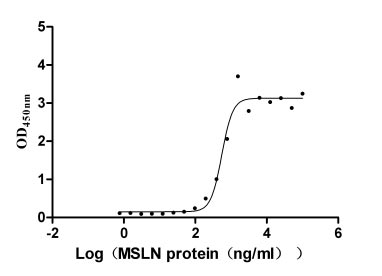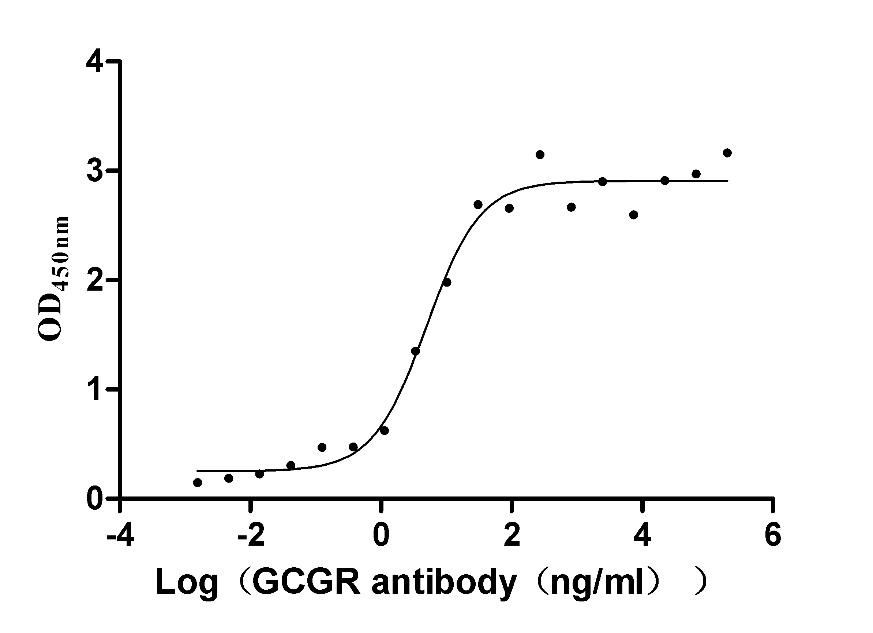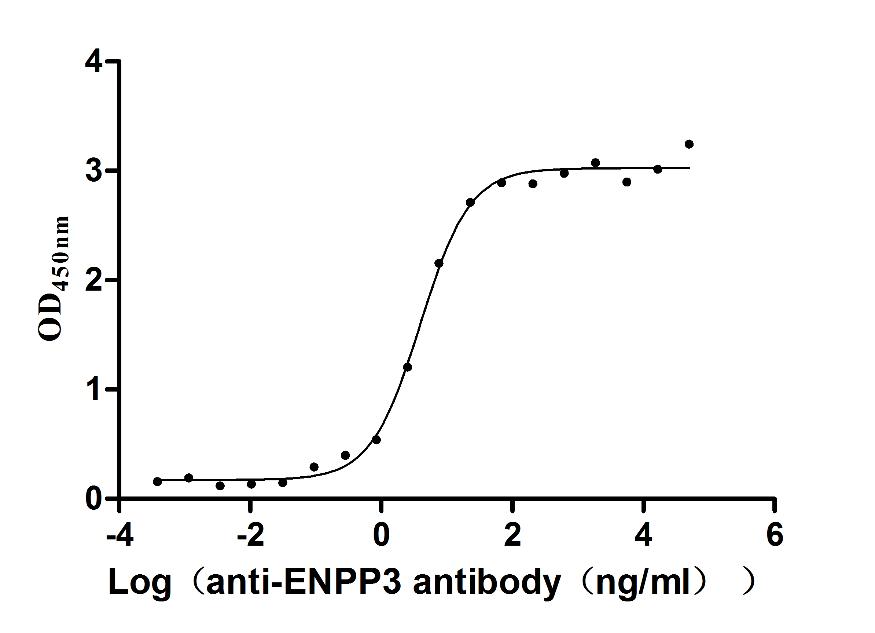Recombinant Escherichia coli DNA-binding protein H-NS (hns)
-
货号:CSB-YP359764ENV
-
规格:
-
来源:Yeast
-
其他:
-
货号:CSB-EP359764ENV-B
-
规格:
-
来源:E.coli
-
共轭:Avi-tag Biotinylated
E. coli biotin ligase (BirA) is highly specific in covalently attaching biotin to the 15 amino acid AviTag peptide. This recombinant protein was biotinylated in vivo by AviTag-BirA technology, which method is BriA catalyzes amide linkage between the biotin and the specific lysine of the AviTag.
-
其他:
-
货号:CSB-BP359764ENV
-
规格:
-
来源:Baculovirus
-
其他:
-
货号:CSB-MP359764ENV
-
规格:
-
来源:Mammalian cell
-
其他:
产品详情
-
纯度:>85% (SDS-PAGE)
-
基因名:hns
-
Uniprot No.:
-
别名:hns; bglY; cur; drdX; hnsA; msyA; osmZ; pilG; topS; b1237; JW1225; DNA-binding protein H-NS; Heat-stable nucleoid-structuring protein; Histone-like protein HLP-II; Protein B1; Protein H1
-
种属:Escherichia coli (strain K12)
-
蛋白长度:Full Length of Mature Protein
-
表达区域:2-137
-
氨基酸序列SEALKILNN IRTLRAQARE CTLETLEEML EKLEVVVNER REEESAAAAE VEERTRKLQQ YREMLIADGI DPNELLNSLA AVKSGTKAKR AQRPAKYSYV DENGETKTWT GQGRTPAVIK KAMDEQGKSL DDFLIKQ
-
蛋白标签:Tag type will be determined during the manufacturing process.
The tag type will be determined during production process. If you have specified tag type, please tell us and we will develop the specified tag preferentially. -
产品提供形式:Lyophilized powder
Note: We will preferentially ship the format that we have in stock, however, if you have any special requirement for the format, please remark your requirement when placing the order, we will prepare according to your demand. -
复溶:We recommend that this vial be briefly centrifuged prior to opening to bring the contents to the bottom. Please reconstitute protein in deionized sterile water to a concentration of 0.1-1.0 mg/mL.We recommend to add 5-50% of glycerol (final concentration) and aliquot for long-term storage at -20℃/-80℃. Our default final concentration of glycerol is 50%. Customers could use it as reference.
-
储存条件:Store at -20°C/-80°C upon receipt, aliquoting is necessary for mutiple use. Avoid repeated freeze-thaw cycles.
-
保质期:The shelf life is related to many factors, storage state, buffer ingredients, storage temperature and the stability of the protein itself.
Generally, the shelf life of liquid form is 6 months at -20°C/-80°C. The shelf life of lyophilized form is 12 months at -20°C/-80°C. -
货期:Delivery time may differ from different purchasing way or location, please kindly consult your local distributors for specific delivery time.Note: All of our proteins are default shipped with normal blue ice packs, if you request to ship with dry ice, please communicate with us in advance and extra fees will be charged.
-
注意事项:Repeated freezing and thawing is not recommended. Store working aliquots at 4°C for up to one week.
-
Datasheet :Please contact us to get it.
相关产品
靶点详情
-
功能:A DNA-binding protein implicated in transcriptional repression (silencing). Also involved in bacterial chromosome organization and compaction. H-NS binds tightly to AT-rich dsDNA and inhibits transcription. Binds upstream and downstream of initiating RNA polymerase, trapping it in a loop and preventing transcription. Binds to hundreds of sites, approximately half its binding sites are in non-coding DNA, which only accounts for about 10% of the genome. Many of these loci were horizontally transferred (HTG); this offers the selective advantage of silencing foreign DNA while keeping it in the genome in case of need. Suppresses transcription at many intragenic sites as well as transcription of spurious, non-coding RNAs genome-wide. Repression of HTG by H-NS is thought to allow their DNA to evolve faster than non-H-NS-bound regions, and facilitates integration of HTG into transcriptional regulatory networks. A subset of H-NS/StpA-regulated genes also require Hha (and/or Cnu, ydgT) for repression; Hha and Cnu increase the number of genes DNA bound by H-NS/StpA and may also modulate the oligomerization of the H-NS/StpA-complex. The protein forms 2 clusters in the nucleoid which gather hns-bound loci together, bridging non-contiguous DNA, and causes DNA substantial condensation. Binds DNA better at low temperatures than at 37 degrees Celsius; AT-rich sites nucleate H-NS binding, further DNA-binding is cooperative and this cooperativity decreases with rising temperature. Transcriptional repression can be inhibited by dominant-negative mutants of StpA or itself. May effect transcriptional elongation. Can increase translational efficiency of mRNA with suboptimal Shine-Dalgarno sequences. Plays a role in the thermal control of pili and adhesive curli fimbriae production, by inducing transcription of csgD. Plays a role in flagellar function. Represses the CRISPR-cas promoters, permits only weak transcription of the crRNA precursor; its repression is antagonized by LeuO. Binds preferentially to the upstream region of its own gene recognizing two segments of DNA on both sides of a bend centered around -150. Overexpression suppresses secY24, a temperature-sensitive mutation. Has also been reported to activate transcription of some genes.
-
基因功能参考文献:
- H-NS specifically represses LEE5 promoter activity and Ler alleviates the repression by H-NS. PMID: 28013045
- Transcription and stability of cas3 in Deltahns cells is limiting for resistance to phage. PMID: 26956996
- we propose that, during E. coli evolution, the conservation of H-NS binding sites resulted in the diversification of the regulation of horizontally transferred genes, which may have facilitated E. coli adaptation to new ecological niches PMID: 26789284
- Through DNA binding, the two proteins interplay to form a transient ternary complex Fpg/DNA/HU which results in the release of Fpg and the molecular entrapment of SSBs by HU PMID: 26392572
- The fdeC gene encodes a protein that is expressed at the cell surface and promotes biofilm formation under continuous-flow conditions and is repressed by the global regulator H-NS. PMID: 25239893
- It was concluded that H-NS exerts maximum repression of LEE5 via the specific sequence at around -138 and subsequently contacts a subunit of RNAP through oligomerization. PMID: 24610333
- Bicyclomycin treatment leads to a decrease in binding signal for H-NS to the E. coli chromosome. PMID: 24499790
- Both the DNA binding sites of H-NS as well as the function of StpA as a backup system might be selected for silencing highly transcribable genes. PMID: 23661089
- We show that H-NS modulates the expression of the nrdAB and nrdDG operons in aerobically and in anaerobically growing cells. PMID: 23873909
- H-NS represses LEE5p by binding to a cluster of A tracks upstream of -114 of the promoter. PMID: 22924981
- RcsB-BglJ activates one of two H-NS-StpA repressed leuO promoters. PMID: 22295907
- The product of bacreriophage T7 gene 5.5 (gp5.5) forms a stable complex with the Escherichia coli histone-like protein H-NS and transfer RNAs (tRNAs). PMID: 22566619
- the attractive force that governs the Cnu-H-NS interaction is an ionic bond, unlike the hydrophobic interaction that is the major attractive force in most proteins. PMID: 22358512
- HNS control the integrase IntI1 and integron promoters expression. PMID: 21778209
- LeuO is a major player in antagonistic interplay against the universal silencer H-NS. PMID: 21883529
- It binds to a middle domain of FliG that bridges the core parts of the rotor and parts nearer the edge that interact with the stator. PMID: 21890701
- Rho-dependent transcription termination is regulated by the H-NS family of proteins. PMID: 21602341
- Combinations of the rho, nusG, and nusA mutations were synthetically lethal, and the lethality was suppressed by expression of H-NS. PMID: 21602355
- a new insight into the bolA regulation network demonstrating that H-NS represses the transcription of this important gene was provided. PMID: 21708124
- H-NS formed 2 compact clusters per chromosome, driven by oligomerization of DNA-bound H-NS through interactions mediated by the amino-terminal domain of the protein; observations demonstrate H-NS plays a key role in global chromosome organization PMID: 21903814
- Chromosomal and plasmidencoded H-NS proteins differ in their functional properties. PMID: 21320594
- H-NS binds to long tracts of DNA, consistent with the linear spread of H-NS binding from high- to surrounding lower-affinity sites; the length of binding regions is associated with the degree of transcriptional repression imposed by H-NS. PMID: 21097887
- H-NS directly controls regulators of stress resistance. PMID: 21034467
- H-NS and LeuO are antagonistic regulators of CRISPR-based immunity. PMID: 20659289
- The global regulator H-NS is required for e xtracellular DNA (eDNA) production since DNA was not detected for the hns mutant and production of H-NS restored eDNA production to wild-type levels. PMID: 20833130
- findings substantiate the central role of RcsB in H-NS-mediated control of motility and acid stress resistance PMID: 20435136
- These results demonstrate an active involvement of H-NS in the induction of the CRISPR-cas system and suggest a potential link between two prokaryotic defence systems against foreign DNA. PMID: 20132443
- Binding of the IHF protein to a site immediately adjacent to fimS is required for phase-on orientational bias; in the absence of LRP and IHF binding, fimS adopts the off orientation and the H-NS protein is required to maintain this orientational bias. PMID: 19889099
- protein-induced DNA bending plays an important role in HU site-specific DNA binding and supports a model of a mutually induced fit. PMID: 15322284
- forms complexes with with YdgT in vivo PMID: 15458420
- data show that the H-NS acts to repress the expression of traM and traJ as cells enter stationary phase, thereby decreasing mating ability to barely detectable levels PMID: 15491366
- Analysis of mechanical response generated by binding of DNA-bending protein Hu to single tethered 48.5 kb lambda-DNA molecules finds that compaction of DNA increases with increasing Hu concentration. PMID: 15504049
- key role for intrinsic conformational changes of Hha in modulating its interaction with H-NS PMID: 15720293
- H-NS directly inhibits gadA and gadX transcription and, by controlling the intracellular level of the activator GadX, indirectly affects the expression of the whole gad system PMID: 15795232
- the expression of the H-NS regulon is sensitive to small changes in the cellular level of H-NS, enabling the cell to response rapidly to environment cues PMID: 15819627
- Results show that LRP binds to the regulatory region of bacterial rRNA promoters, and may contribute in combination with H-NS to the control of rRNA synthesis. PMID: 16238633
- The oligomerization capacity of H-NS in vivo is effected by temperature, pH, and osmolarity. PMID: 16303134
- StpA complements H-NS proteins defective in DNA binding to repress bgl, while in autoregulation of stpA it acts autonomously, indicating a difference in the mechanisms of repression. PMID: 16980475
- role of hns in regulation of RpoS; findings suggest that H-NS regulates an RssB inhibitor or inhibitors PMID: 16980505
- The results support the conclusion that the bacterial DNA-binding protein LRP, assisted by H-NS, forms a repressive nucleoprotein structure involved in regulation of rRNA transcription. PMID: 17196617
- Identified as new member of the polyamine modulon together with RpoN and Cra. PMID: 17220219
- crystal structure of the Escherichia coli nucleoid-associated HUalphabeta protein PMID: 17360520
- The binding of H-NS to a transposase protein is a novel function for this important regulatory molecule. PMID: 17501923
- analysis of H-NS repression by binding within the transcription unit PMID: 17569663
- Data Show that H-NS prevented binding of RNA polymerase (RNAP) at the Hemolysin Protein E promoter (PhlyE). PMID: 17892462
- The model for the functions of H-NS in homologous recombination and double-strand break repair is discussed PMID: 17991999
- LeuO and H-NS regulate the expression of the yjjQ-bglJ operon and yjjP. PMID: 18055596
- H-NS is shown to be a common regulator of multiple iron and other nutrient acquisition systems preferentially expressed at 37 degrees C and of general stress response, biofilm formation, and cold shock genes highly expressed at 23 degrees C. PMID: 19011022
- At 37 degrees C, SlyA activates transcription of K5 capsule independent of H-NS but maximal transcription requires H-NS. PMID: 19114478
- StpA binding profile reduced to one-third in the hns mutant and the H-NS binding profile was unaffected by stpA inactivation. PMID: 19151137
显示更多
收起更多
-
亚细胞定位:Cytoplasm, nucleoid.
-
蛋白家族:Histone-like protein H-NS family
-
数据库链接:
KEGG: ecj:JW1225
STRING: 316385.ECDH10B_1297
Most popular with customers
-
Recombinant Human Mucin-16 (MUC16), partial (Active)
Express system: Mammalian cell
Species: Homo sapiens (Human)
-
Recombinant Human Glucagon receptor (GCGR), partial (Active)
Express system: Mammalian cell
Species: Homo sapiens (Human)
-
Express system: Mammalian cell
Species: Macaca fascicularis (Crab-eating macaque) (Cynomolgus monkey)
-
Recombinant Mouse Complement component C1q receptor (Cd93), partial (Active)
Express system: Mammalian cell
Species: Mus musculus (Mouse)
-
Recombinant Human Oncostatin-M (OSM), partial (Active)
Express system: Mammalian cell
Species: Homo sapiens (Human)
-
Recombinant Rat Gastric inhibitory polypeptide receptor (Gipr), partial (Active)
Express system: Mammalian cell
Species: Rattus norvegicus (Rat)
-
Recombinant Human CD70 antigen (CD70), partial (Active)
Express system: Mammalian cell
Species: Homo sapiens (Human)
-
Recombinant Human C-C chemokine receptor type 5 (CCR5)-VLPs (Active)
Express system: Mammalian cell
Species: Homo sapiens (Human)




















